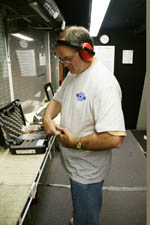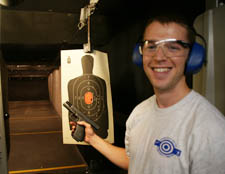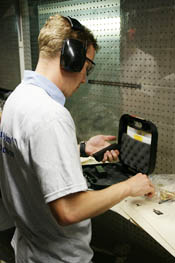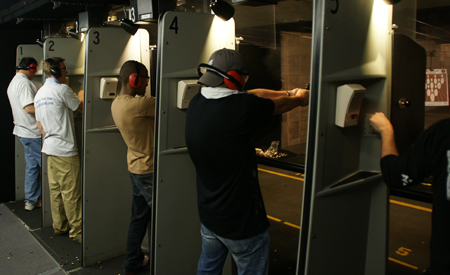 In two days, Teddy O’Reilly will marry his college sweetheart, but tonight he’s going shooting.
In two days, Teddy O’Reilly will marry his college sweetheart, but tonight he’s going shooting.
A bachelor party should be a smashed-up cocktail of testosterone and adrenaline. As the best man, I’m in charge of the night. A week ago, I called Fred Harris Jr. at Deerfield Pistol and Archery Center in southern Wisconsin, a half-hour drive from the wedding site in Madison. For $175, our bachelor-party group will have the place to itself for two hours, including guns, targets and earmuffs. Ammo is extra.
When Fred was hired at Deerfield four years ago, he started promoting the range as a venue for private events. Shooting ranges love bachelor parties.
 “We get at least a bachelor party a day, and on a busy weekend, we’ll see 10 bachelor parties on a Saturday,” says Mike Heck, range manager at The Gun Store, a Las Vegas, Nev., shooting range that fires off 100,000 rounds a week. “The vast majority of our clientele are people with little to no experience, and that’s increased over the last 10 years.”
“We get at least a bachelor party a day, and on a busy weekend, we’ll see 10 bachelor parties on a Saturday,” says Mike Heck, range manager at The Gun Store, a Las Vegas, Nev., shooting range that fires off 100,000 rounds a week. “The vast majority of our clientele are people with little to no experience, and that’s increased over the last 10 years.”
Introductions
The drive from Madison to Deerfield is green and calm, the fields lined with young corn stalks and small herds of cows clustered near barns. I ride with Teddy’s father-in-law to be, Jim Lynes, who tells me about teaching his daughter Kristen (the bride) to shoot using the family’s double-barreled .45-caliber muzzleloader.
The three cars carrying the bachelor party pull up to the Deerfield shooting range, and we go inside, excited and talking loud. We walk toward a short, square man with a shaved head standing behind a glass case. This is Fred, the range’s firearms instructor; 32 years old with a gun on his hip.
“Who’s the guy that’s about to make the worst mistake of his life?” Fred asks.
Teddy raises his hand, and we all laugh.
 Fred’s a character. He paid to have one of his guns painted pink, because, “I like to go to a range and outshoot people with a pink gun.”
Fred’s a character. He paid to have one of his guns painted pink, because, “I like to go to a range and outshoot people with a pink gun.”
There are 11 of us; two of Teddy’s new in-laws, one of his brothers, and eight guys from his high-school and college running teams. Eamon O’Reilly, Teddy’s older brother, is a Navy surgeon with two children and a constant smirk. Simon Bairu, who Teddy ran with at the University of Wisconsin, won the NCAA cross-country championship two consecutive years.
Fred leads us into a nearby room, which is empty except for a folding table, a few chairs and law-enforcement patches from across the country hanging in a long line high on the wall. Scott Whiting, who owns the range, is a police officer in a nearby town, and he traded for most of the patches at law-enforcement training events. The range now sports patches from as far away as Italy and Israel, and a Marine who uses the range even contributed a patch from an Iraqi police department (the words are in Arabic).
We’ll be shooting five guns, one for each lane in the range downstairs. There’s a Bushmaster AR-15 9 mm carbine, Smith and Wesson M+P .40 caliber, Glock Model 17 9 mm, Taurus Model 85 .38 special and Taurus Model PT 1911 .45 ACP.
 Our cheerful band won’t win any marksmanship prizes. When Fred asks who has never shot a gun before, almost half of us raise our hands, and when he holds up the AR-15 somebody says, “I’m not shooting that thing.” He demonstrates the principals with an unloaded Glock, curling his thumbs around the butt “like you’re bumping a volleyball.” He tells us to keep our thumbs “high on the tang,” and discusses what he calls the self-induced evolution.
Our cheerful band won’t win any marksmanship prizes. When Fred asks who has never shot a gun before, almost half of us raise our hands, and when he holds up the AR-15 somebody says, “I’m not shooting that thing.” He demonstrates the principals with an unloaded Glock, curling his thumbs around the butt “like you’re bumping a volleyball.” He tells us to keep our thumbs “high on the tang,” and discusses what he calls the self-induced evolution.
“If you cross your thumbs, the slide will come back and take a chunk of your knuckles off, and you’ll evolve to never do that again,” he says.
Finished with the basics of loading and safety (“Leave with the same amount of holes you came in with”), Fred leads us through a hall decorated with signed photographs of Brett Favre and then down a steep flight of stairs. Everyone makes nervous jokes about Bruce Willis in Pulp Fiction. Now we’re in the small observation room, directly adjacent to the actual range, with only a soundproofed door for separation. Fred takes five of us at a time through the door to finish our tutorial and take a few practice shots.
 Fire in the Hole!
Fire in the Hole!
The range is the width and height of a one-car garage, but 60 feet long, with stalls similar to those that flank a urinal. Each of the lanes has a narrow counter at waist level on which to set the guns when you’re not shooting. There’s a similar surface running the length of the wall behind the stalls, where we stack ammunition and targets.
After we take a few shots apiece, Fred leaves us alone with the guns and goes back upstairs. The serious shooting begins. I load one of the Glocks with four of five bullets and let loose. Wow. Shooting a gun for the first time is exhilarating and scary, like riding a skateboard down a steep hill. I was writing when Fred explained the thumb situation, and I don’t think I’m doing it right. Even though I only sent the target out to the 10-foot mark, I’m not causing the silhouette much harm. The closest I get is creasing its shoulder on my last shot.
I move one lane to my right and try the .38 Special, a pretty all-black revolver made by Forjas Taurus, a 67 year-old Brazilian company. I like this little guy. If I were going to have one gun, just for tomcatting around town, this would definitely be it. At first, I have some trouble. For some reason, nothing happens when I pull the trigger. I keep trying, and I can see the cylinder spinning away, but there’s no sound except the small click-click-click of the hammer hitting the shells.
 Ah, the shells. The previous shooter left his empties in the gun. I flip the cylinder out and let the shiny empty shells fall around my feet, and I slide in five bullets. Game time. I raise the gun toward the target, one-handed this time, and squeeze off five shots. Boom, boom, boom, boom, boom, click, click, click. I keep pulling the trigger after the five; I like seeing the cylinder spin. Man. This is definitely my favorite gun.
Ah, the shells. The previous shooter left his empties in the gun. I flip the cylinder out and let the shiny empty shells fall around my feet, and I slide in five bullets. Game time. I raise the gun toward the target, one-handed this time, and squeeze off five shots. Boom, boom, boom, boom, boom, click, click, click. I keep pulling the trigger after the five; I like seeing the cylinder spin. Man. This is definitely my favorite gun.
I set the .38 down and watch the others shoot. None of us are very good, and unless the target is close, the silhouettes come back in about the same condition in which they went out. Everybody’s grinning like crazy men, though.
We shoot for an hour before the plastic bags of bullets empty out. Fred sent us downstairs with 200 rounds of 9 mm and 100 rounds each of the .38-, .40- and .45-caliber ammunition. Two guys jog back upstairs, and Fred sends them back down with another 500 rounds.
“The average person will shoot 50 rounds an hour,” Fred says, so we’re not too far below par in that department, at least.
“Look at Simon going downtown!” yells Bobby Lockhart, a track coach at the University of Oklahoma, as Simon sends his target out the full 60 feet and blasts away. “When I go back in there, I’m going all out, way downtown. I gotta try!”
Everybody’s covered in powder residue at this point, and I have black marks on my shirt from where I held a magazine as I filled it with bullets.
“Women dig that scent,” says Ben Porter as he sniffs his shirt.
 Jim walks back into the observation deck nursing an injured hand.
Jim walks back into the observation deck nursing an injured hand.
“I wrapped my thumb around and took a chunk of my thumb off,” he says. “I evolved. Only have to do that once.”
Someone points out the first-aid kit bolted to the wall and observes that we’re lucky to have a doctor with us. Eamon is in his fifth year of residency at the Navy Medical Center in San Diego and says he’ll be going to Iraq when he graduates.
“Since I’m a surgeon, we didn’t do any weapons training,” he says. “I’m not going to be carrying a gun in Iraq.”
We shoot for just more than two hours, a lot longer than most groups at other ranges. The range manager at Las Vegas’ The Gun Store said most of their customers finish up in “35 to 40 minutes from beginning to end. The lines at Disney Land are much longer, I assure you.” That makes sense to me. When you’re not used to it, two hours shooting can feel like a long time.
 Teddy, the husband to be, has the best time of all. He shoots with his left arm tucked behind his back, like he’s dueling in 17th century England. I’ve known Teddy for 10 years, since our skateboarding junior-high days, and I think this is the happiest I’ve ever seen him.
Teddy, the husband to be, has the best time of all. He shoots with his left arm tucked behind his back, like he’s dueling in 17th century England. I’ve known Teddy for 10 years, since our skateboarding junior-high days, and I think this is the happiest I’ve ever seen him.
When we were growing up in Alaska, Teddy was one of the fastest runners in the state, and the Anchorage Daily News dubbed him “The Professor” for running races in his wire-rimmed glasses. He’s also a huge World War II buff. While I wheezed and struggled to keep up as we trained on icy back roads, Teddy would describe the differences between German and Russian tanks to me in a calm, measured voice.
Teddy would love the options at Las Vegas’ The Gun Store, especially the World War II Package. For $99.95, a historically inclined shooter can fire a Thompson machine gun, German MP-40 and German 9 mm handgun. For those more interested in current events, the $109.95 Coalition Package lets you shoot the same weapons used by our soldiers in Iraq and Afghanistan: an M-16 rifle, a Beretta 92 and the belt-fed M249 SAW. Both packages include targets, some ammunition and even a t-shirt.
After 1,000 rounds, we’re all done. Fred comes back downstairs and directs us in sweeping up the mess. Targets go in the trash, and we use long push brooms to mound the shells into piles. I walk back toward the sloped wall of rubber pellets that serves as the range’s backdrop and pick up a few bullets. Some are still in their copper jackets and still shaped like they were when they came out of the gun, but most are smashed and twisted into what looks like stepped-on Skittles.
 “Once a year, we take all the lead out,” Fred says, “usually about 20,000 pounds of lead.” The range gets about a buck a pound selling the metal to a company that reloads it back into new ammunition.
“Once a year, we take all the lead out,” Fred says, “usually about 20,000 pounds of lead.” The range gets about a buck a pound selling the metal to a company that reloads it back into new ammunition.
Training Complete
We walk back upstairs, and Fred tells me I’m lucky I caught him during the slow season. A month earlier, and the range wouldn’t have been available for rent. Cold weather forces shooters inside, but the June warmth releases them.
Upstairs, Fred hands me the bill: $407. Geez, ammo’s expensive. I call out, “$40 each, guys,” and everybody hands over creased 20s. I toss in $45, bum two singles and spread the cash out in five stacks for Fred.
“Still have time to change your mind,” he says to Teddy.
“That wouldn’t be a good idea, now that the father-in-law is trained in firearms,” Jim says with a laugh.
— Josh Saul is a free-lance writer from New York.

![Best Concealed Carry Guns In 2025 [Field Tested] Wilson Combat EDC X9S 1](https://gundigest.com/wp-content/uploads/Wilson-Combat-EDC-X9S-1-324x160.jpg)


![Best 9mm Carbine: Affordable PCCs [Tested] Ruger Carbine Shooting](https://gundigest.com/wp-content/uploads/Ruger-Carbine-Shooting-100x70.jpg)
![Best AR-15: Top Options Available Today [Field Tested] Harrington and Richardson PSA XM177E2 feature](https://gundigest.com/wp-content/uploads/Harrington-and-Richardson-PSA-XM177E2-feature-100x70.jpg)
